|
|
| AFRICA 2007 - Part Two
|
Monday, April 23, 2007
We slept in until about 6:45 – slept really well! We made some coffee and hung around in the room until about 8:00 then went up to the lodge. Breakfast was at 8:30 with cereal, fruit, juice, bacon, potatoes, sausage, tomatoes and freshly cooked eggs, toast, coffee or tea. We also took some pictures of some hornbills trying to eat some fruit in a tree.
|
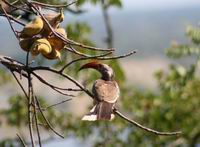
|
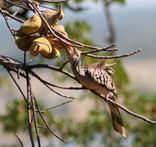
|
|
We read and lounged about until 10:00 when our two game trucks departed for Chobe National Park. In our truck we had Zambo, our guide, Rodney and Jane, Pat and Vicky and the two of us. We took the back row of seats – I had emptied everything out of my Canon Photo backpack and put in the two cameras – one with a 70-300mm lens and one with a wide angle lens, along with spare batteries. It is well padded, so I put it on the seat between us and just pulled the camera out when needed.
We barely got out of the parking space when we came upon baboons and kudu just off the road. We just left the concession when Zambo stopped the truck and pointed out a leopard tortoise beside the road. The leopard tortoise is one of the "Little Five" game animals of Africa, fitting in with the Buffalo Weaver (bird), Elephant Shrew, Rhino Beetle, and the Ant Lion. A little further down a waterbuck doe stood and posed for us. Around the next corner was a small herd of elephants destroying some trees for breakfast. That was the first five minutes.
|
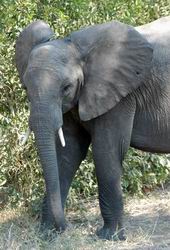
|
|
|
|
We drove about 30 km on paved roads to one of the park entrances, then about 9 km on dirt roads to the river. We stopped to watch a dung beetle trying to roll his ball of dung across the tire tracks (without much success), ground hornbills, and some cape buffalo.
|
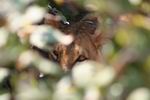
|
Near the river we found a truck from another lodge stopped near a brush thicket where several lions were sleeping off a buffalo kill (one leg and part of a rib cage were still lying nearby). There was at least one cub but it was difficult to see and the trucks are not supposed to go off the road in Chobe. One of the lionesses had a tracking collar around her neck. We stopped for lunch with the other Muchenje truck – salads, cold roast beef, cold chicken, quiche – right near the river.
|
| 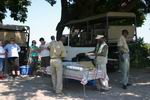
|
|
After lunch we transferred to a small covered boat with seats for about 15 people. The other Muchenje guide, Lips, went with us. We headed east on the Chobe River for about two hours and saw (in no particular order):
ELEPHANTS, including a bull that waded out into the river and onto a small island to get a better look at us. He gave us a threat display, twisting his trunk and shaking his head, before deciding that we weren't worth any further effort.
|
|
| 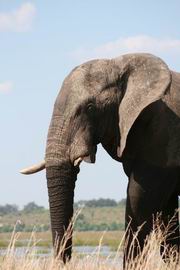
|
|
|
BIRDS, including:
Marabou storks, also called "Undertaker Birds". They can stand up to four and a half feet high with a wingspan of nearly nine feet, and sadly are NOT attractive fellows, even in comparison to the Vultures.
The Kori Bustard, a large bird weighing about 30 pounds, it can fly, but generally prefers to stay on the ground.
Fish Eagles, which are lovely birds with snowy white feathers covering their head and chest, and Bateleurs, another medium-sized eagle.
The ever-present Guineafowl, called "Botswana Chickens" by our guides, scurrying around in small flocks.
The nearly ever-present Lilac Breasted Roller ("LBR"), one of the birds in contention for the title of National Bird of Botswana. They are lovely, with brilliant blue, green, turquoise and (of course), lilac feathers.
|
|
We also saw several Kingfishers, including one that had caught a fish and was busy tenderizing it on a branch. He held the fish in his beak and would whack it against the branch a few times, and then try to swallow it, with more whacking if he wasn't satisfied with the consistency. The bird in the middle photo is a female, distinguished by the lack of a secondary black band on her chest.
|
|
We came across a pretty large, err, "flotilla" of hippos in the water. It was hard to get a read on how many there were since they would surface and submerge often.
|
|
There were several type of antelope that came to the river to drink:
Kudu, a large antelope that is kind of two-toned grey and brown. The males have long corkscrew horns.
Impala, the "pigeons" of the antelope world, the females stay together attended by a single male. If the male is challenged by another male and is unseated, he goes to live in a bachelor herd until he is able to challenge another male for a breeding herd of females again. The males make a loud growling noise during mating season.
Puku, a medium-sized, stocky antelope that looks similar to the Red Lechwe. One of the bucks that we saw had a large wound on his back.
|
|
We saw a little family of warthogs that had come down out of the bush. Mom and the warthoglets were up on the bank digging around for some grub while dad was chilling out in the mud.
|
|
Did I mention elephants? Chobe National Park is home to the largest concentration of elephants in Africa, estimated at 120,000, with probably about one-third in the area near the eastern portion of the Chobe River. At one point we came across a gathering of about 60 animals along the bank of the river, drinking, playing, washing. It was amazing. We could get quite close to them even in the boat.
|

|
|
Elephants live in herds dominated by a matriarch; most of the elephants in the herd will be her close relatives (sisters, daughters and their offspring and young sons). Once a male elephant reaches maturity (around 14 years old), he will leave the herd and live on his own, or in a small bachelor group.
An elephant's gestation period is 22 months. Like human infants, baby elephants are born with very few survival instincts and must rely on their elders to teach them. All members of the herd participate in the care and raising of the young elephants, and are very protective. They are very social and tactile, and they use their trunks to touch and caress one another.
|
|
| 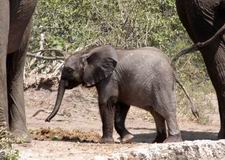
|
|
|
An elephant's trunk is very versatile, and used for a variety of tasks: smelling, breathing, eating, drinking. Elephants suck water up into their trunks (up to 14 liters) and then blow it into their mouths. They will also use their trunks to spray water on themselves and cover themselves with dirt to provide a protective sunscreen against the hot sun.
|
|
Both male and female African elephants have tusks, and they use them for digging for water, salt or roots, stripping bark off trees, for moving branches and clearing paths, and occasionally as weapons. Like humans, elephants are usually right- or left-tusked, and the dominant tusk is normally shorter and more rounded at the end due to wear. While the tusks are permanent, they have six sets of teeth during their lifetime; older teeth are worn down and replaced over time. Once their last teeth have been worn down, an elephant cannot eat and dies of starvation. They may live to be 70 years or older, and would probably live longer if their teeth did not wear down.
We watched a couple of elephants mock-fighting in the water, using their trunks and tusks in a series of complicated wrestling moves.
|
|
We also saw a few Crocodiles but they were too far away to get any good photos. This guy, however, was in no hurry - this is a Water Monitor or Leguaan. They are related to the Komodo Dragon and can grow to seven feet in length. This one was probably about three feet long, hanging out on the bank.
|
|
After we returned to the trucks, we took the river road back toward Muchenje. We saw a small herd of elephants enjoying a dust bath and they let us get very close. VERY CLOSE.
|
|
We stopped for a “sundowner”, the traditional safari drink and snacks as the sun sets. We saw a troop of baboons - some were sitting and grooming one another, but there were a dozen or so that were hanging off of the branches of a dead tree - a true "Jungle Gym".
|
|
We had the company of a "journey" of giraffes for a while, watched a large herd of buffalo eyeing us from up the road and could see several elephants on an island in the river.
|
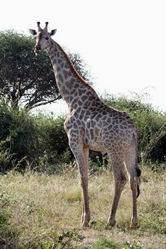
|
|
| 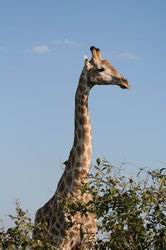
|

|
|
We had to leave Chobe by 6:30, as the park is closed at night, and we made it with only about ten minutes to spare. We showered, changed, downloaded pictures to our digital wallet, recharged batteries and packed, as we leave sometime tomorrow morning for Shinde.
We went down for a drink at the bar before dinner, nibbled on some very tasty meatballs and spoke with Jeff, the other manager. He has been to the states three times (west coast, New Orleans/Orlando, and NYC). If he could live anywhere, it would be New York. At dinner, Vera reiterated that it was Jeff’s first wish to line in NYC. Quite a change from Botswana game camps!
We sat with Vera, Zambo and Dan (another guide) for dinner. Dan is new to this area as a guide – he spent five years in the Delta, but only saw his family every 90 days. He LOVES the Delta, but it was too much time away. He loves watching animal behaviors – for example, he watched the interaction between elephants and buffalo trying to cross the river at the same time (hint: the elephants had the right-of-way).
Dinner was creamy mushrooms on toast (very nice), stir fry veggies, beef curry, roast chicken, rice, potatoes, butternut squash, with cheesecake for dessert. We headed off for bed, and I called Mom. Kind of a poor connection, but hey, it’s Botswana!
Tuesday, April 24
A wake-up knock at 5:30 and we were up, packed, dressed and having a cup of coffee by ten till six. It was the two of us and the Aussies off for an early game drive this morning, with Lips as our guide. We drove along the paved Chobe road for about twenty minutes – it was pretty darned cold this morning - and then turned toward the river.
|
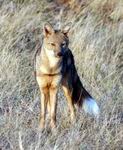
|
We saw buffalo, impala, kudu, lechwe, a side-striped jackal, tawny eagles, and a bateleur. Lips tracked a male lion’s tracks for a while, but we didn’t see him. And the strange thing was that after yesterday’s elephant encounter, we didn’t see a single one. I guess they stay up in the trees until later in the day when they come down to drink.
|
| 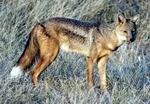
|
|
We arrived back in camp at 8:40, with just enough time to have a quick bite to eat before we were off to the Kasane airport along with Diana, Roger and Dave. Zambo drove us and we saw two large secretary birds along the way. They are unusual, having an eagle-like body on crane-like legs, standing about four feet tall.
We arrived at the airport a little before 10:00 and had our bags x-rayed. Gary had to open his to discover that a mysterious reading was a pack of AA batteries. We waited in the domestic departure lounge (just the five of us), until Steve, our pilot arrived. He was South African, probably about 40, and wearing a Ker & Downey fleece, shorts and teva sandals. He apologized for not being able to hear out of one ear as he has a cold and his ear popped on the way over from Maun. He loaded the bags and us – Gary and I in the back, Roger and Diana in the middle and Dave flying shotgun.
Steve said that the air traffic controller was back together with his girlfriend, which meant that we would be allowed to turn to the left over the river and get some nice views. When he and “Grace” are on the outs, all the pilots have to turn right.
Fifty minutes to Selinda and I was only moderately terrified. We flew west along the Chobe and we could see the spots where we had been on the boat the day before. We landed at a dirt strip and the Selinda driver arrived to collect Diana, Roger and Dave. They will spend two nights here and then we will see them at Shinde.
We said goodbye and took off on our eighteen minutes flight to Shinde. Steve pointed out some elephants hiding in the lagoon and said that during the last two minutes of the flight we might be able to see the flood waters at the top of the Delta, as Shinde is one of the northern-most camps in the Okavango.
|
 |
|
| |